Related Research Articles
Hecht's, also known as Hecht Brothers, Hecht Bros. and the Hecht Company, was a large chain of department stores that operated mainly in the mid-Atlantic and southern region of the United States. The firm originated in Baltimore, Maryland.
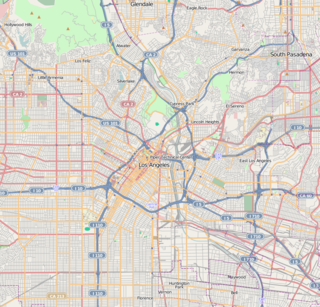
Broadway, until 1890 Fort Street, is a thoroughfare in Los Angeles County, California, USA. The portion of Broadway from 3rd to 9th streets in the Historic Core of Downtown Los Angeles, was the city's main commercial street from the 1910s until World War II, and is the location of the Broadway Theater and Commercial District, the first and largest historic theater district listed on the National Register of Historic Places (NRHP). With twelve movie palaces located along a six-block stretch of Broadway, it is the only large concentration of movie palaces left in the United States.
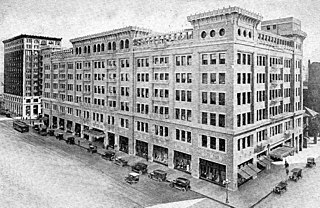
J. W. Robinson Co., Robinson's, was a chain of department stores operating in the Southern California and Arizona area, previously with headquarters in Los Angeles, California.
I. Magnin & Company was a San Francisco, California-based high fashion and specialty goods luxury department store. Over the course of its existence, it expanded across the West into Southern California and the adjoining states of Arizona, Oregon, and Washington. In the 1970s, under Federated Department Stores ownership, the chain entered the Chicago, Illinois, and Washington, DC, metropolitan areas. Mary Ann Magnin founded the company in 1876 and named the chain after her husband, Isaac.
The Broadway was a mid-level department store chain headquartered in Los Angeles, California. Founded in 1896 by English-born Arthur Letts, Sr., and named after what was once the city's main shopping street, the Broadway became a dominant retailer in Southern California and the Southwest. Its fortunes eventually declined, and Federated Department Stores bought the chain in 1995. In 1996, Broadway stores were either closed or converted into Macy's and Bloomingdales.
Jewish Texans have been a part of the history of Texas since the first European explorers arrived in the region in the 16th century. In 1990, there were around 108,000 adherents to Judaism in Texas. More recent estimates place the number at around 120,000.
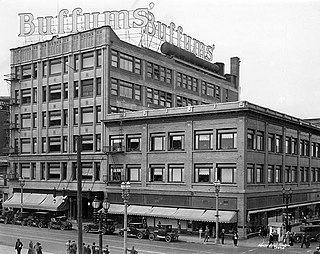
Buffums, originally written as Buffums' with an apostrophe, was a chain of upscale department stores, headquartered in Long Beach, California. The Buffums chain began in 1904, when two brothers from Illinois, Charles A. and Edwin E. Buffum, together with other partners, bought the Schilling Bros., the largest dry goods store in Long Beach, and renamed it The Mercantile Co. The store grew to a large downtown department store, and starting in the 1950s, grew slowly over the years to be a small regional chain of 16 speciality department stores across Southern California at the time of its closure in 1990.

Samuel Tilden Norton, or S. Tilden Norton as he was known professionally, was a Los Angeles-based architect active in the first decades of the 20th century. During his professional career he was associated with the firm of Norton & Wallis, responsible for the design of many Los Angeles landmarks.
B. Forman Co. was a retail store in Rochester, New York specializing primarily in high-end women's clothing. Once the largest store of its kind between New York and Chicago, the company, founded by Benjamin Forman in the first decade of the twentieth century, closed in 1994. B. Forman Co., along with McCurdy & Co., created Rochester's Midtown Plaza, one of the first enclosed Downtown malls in the United States.

Desmond's was a Los Angeles-based department store, during its existence second only to Harris & Frank as the oldest Los Angeles retail chain, founded in 1862 as a hat shop by Daniel Desmond near the Los Angeles Plaza. The chain as a whole went out of business in 1981 but Desmond's, Inc. continued as a company that went in to other chains to liquidate them. Desmond's stores in Northridge and West Covina were liquidated only in 1986 and survived in Palm Springs into the first years of the 21st century.

Harris & Frank was a clothing retailer and major chain in the history of retail in Southern California, which at its peak had around 40 stores across Southern California and in neighboring states and regions. Its history dates back to a clothing store founded by Leopold Harris in Los Angeles in 1856 near the city's central plaza, only eight years after the city had passed from Mexican to American control. Herman W. Frank joined Harris in partnership 32 years later in 1888.
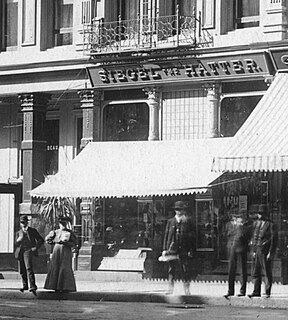
Myer Siegel was a Los Angeles-based department store, founded by Myer Siegel (1866–1934), specializing in women's clothing.
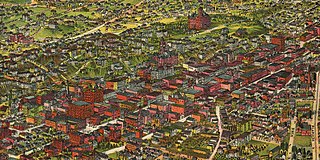
The late-Victorian-era Downtown of Los Angeles grew year by year, around 1880 centered at the southern end of the Los Angeles Plaza area, and over the next two decades, extending south and west along Main Street, Spring Street, and Broadway towards Third Street. Most of the 19th-century buildings no longer exist, surviving only in the Plaza area or south of Second Street. The rest were demolished to make way for the Civic Center district with City Hall, numerous courthouses, and other municipal, county, state and federal buildings, and Times Mirror Square. This article covers that area, between the Plaza, 3rd St., Los Angeles St., and Broadway, during the period 1880 through the period of demolition (1920s–1950s).

Jacoby Bros. was one of Los Angeles' largest dry goods retailers in the 1880s and 1890s, developing over the decades into a department store, which closed in the late 1930s.

B. H. Dyas Co. was a Los Angeles sporting goods retailer that turned into a department store and went out of business in the 1930s, owned by Bernal Hubert Dyas (1882–1959).

7th Street is a street in Los Angeles, California running from S. Norton Ave in Mid-Wilshire through Downtown Los Angeles. It goes all the way to the eastern city limits at Indiana Ave., and the border between Boyle Heights, Los Angeles and East Los Angeles.

Parmelee-Dohrmann was a Los Angeles-based chain of stores that sold fine china, crystal, glassware, silver, and objects of art.

Nugents or B. Nugent & Brother Dry Goods Co. was a department store in Downtown St. Louis, Missouri at the southeast corner of Washington Avenue and Broadway. It was the first downtown department store in the United States to open a suburban branch.

Retail in Southern California dates back to its first dry goods store that Jonathan Temple opened in 1827 on Calle Principal, when Los Angeles was still a Mexican village. After the American conquest, as the pueblo grew into a small town surpassing 4,000 population in 1860, dry goods stores continued to open, including the forerunners of what would be local chains. Larger retailers moved progressively further south to the 1880s-1890s Central Business District, which was later razed to become the Civic Center. Starting in the mid-1890s, major stores moved ever southward, first onto Broadway around 3rd, then starting in 1905 to Broadway between 4th and 9th, then starting in 1915 westward onto West Seventh Street up to Figueroa. For half a century Broadway and Seventh streets together formed one of America's largest and busiest downtown shopping districts.
References
- ↑ "Korrick's advertisement from 1920".
- ↑ "The Korrick Brothers of Phoenix, The New York Store & Korrick's Department Store – JMAW – Jewish Museum of the American West". www.jmaw.org.
- ↑ "Korrick's Downtown Expansion". November 17, 1957. p. 4 – via newspapers.com.
- ↑ "About". departmentphx.com.
- ↑ "Mid-Century Korricks Department Store". Arizona Jewish Historical Society.